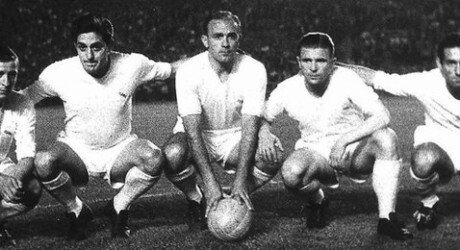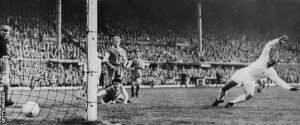Homage to di Stefano
Roy Hay
The death of Alfredo di Stefano at the age of 88 has robbed us of one of the greatest players the world of football has ever seen. Though a modern generation would mention Maradona, Lionel Messi, Pele as incomparable superstars, it is arguable that over his long career di Stefano exceeded all of them and his contemporaries Ferenc Puskas and Stanley Matthews.
Alfredo di Stefano won league championships in Argentina, Colombia and Spain and represented all three countries though never in a World Cup final tournament. With Real Madrid from 1956 to 1960 he won the first five European Cups (now the Champions League), a feat that is never likely to be repeated. Real won the Spanish League eight times while he was playing for them, plus the Spanish Cup and the intercontinental cup.
Earlier in his career he had helped River Plate win the Argentinian league in 1945 and 1947, then moved to Colombia to play for the well-named Millonarios leading them to the league title four times. At that time Colombia, like Australia from 1958 to 1963, had its membership of FIFA suspended for persistent breaches of the rules of the world body. So his four international appearances for Colombia are not recognised, though his six games for Argentina and 31 caps for Spain are in the official record books. He was twice European player of the year in 1957 and 1959.
I saw him play in the flesh twice. The second occasion was the European Cup final of 1960 at Hampden Park, which Les Murray and I believe is still the greatest game ever played, because it opened our eyes to level and quality of play that we had never believed to be possible. Real Madrid beat Eintracht Frankfurt seven-three in a stunning display of attacking football in which di Stefano scored a hat-trick and his partner Puskas scored four. Eintracht had beaten the cream of Scottish football, Glasgow Rangers, 12–4 over the two-leg semi-final, so they were no mugs, but that night in May 1960 at Hampden Park in front of 137,000 and probably more Scots they were simply outclassed. Di Stefano ran the game, as he often did, picking the ball up in defence from the centre-back Santamaria then loping forward, so it seemed, though he covered the ground like a gazelle, spraying passes to left and right and then being in the opposition penalty area to score or support the attack.
After the game the crowd did not move for roughly an hour mesmerised and almost unbelieving at what they had seen. They insisted Real return to the field to receive their acclamation before they finally departed. I came out of the ground horizontally balanced on the heads and shoulders of the tightly packed crowd. I had seen a master at work at the peak of his career.
But that was not the first occasion I saw di Stefano in action. I was only sixteen when he came to Hampden in May 1957 during the qualifying competition for the World Cup in Sweden. Spain were expecting to run all over the Scots with a forward line which included Ladislav Kubala, di Stefano, Luis Suarez and Francisco Gento. But George Young and the Scottish defence held firm and wee Jackie Mudie of Blackpool scored a hat-trick for the Scots and John Hewie converted a penalty kick, while Kubala and Suarez replied for Spain. You could not but admire di Stefano’s efforts to turn the tide but Tommy Docherty, Ian McColl and Bobby Collins conspired to keep him from dominating the match. The Spanish national side was not as attuned to his promptings as his Real Madrid colleagues. Spain and di Stefano restored Spanish pride with a four-one reversal of the outcome in Madrid a couple of weeks later, but Scotland qualified for the World Cup.
After his playing career ended he returned to Argentina to coach Boca Juniors and River Plate to league championships, then came back to Spain to take Valencia to the La Liga title. In 1982 Real summoned him back as coach but finished as runner up in five competitions during his tenure. One defeat in a final was in 1983 in the Cup Winners Cup when Aberdeen won its first European title under Alex Ferguson. On the advice of another legendary Scottish manager, Jock Stein, Ferguson presented di Stefano with a bottle of single malt before the game to give the impression that he was conceding that his side could not match Real. But they did by two goals to one in pouring rain in Norway. Di Stefano coached Real again in 1990 beating Barcelona in the Super Cup and in 2000 he became Honorary President of the club a post he held until the end.
Every one of the greats of the code who has commented on his passing has paid tribute to his skill, his status and his complete command of the game. He had a huge influence on generations of players around the world. Let Sir Bobby Charlton describe his contribution, ‘He takes the ball from the goalkeeper; he tells the full-backs what to do; wherever he is on the field he is in position to take the ball; you can see his influence on everything that is happening…I had never seen such a complete footballer’.









Marnie Haig-Muir: Your review of the latest Rankin is right on the money, Roy. This book...